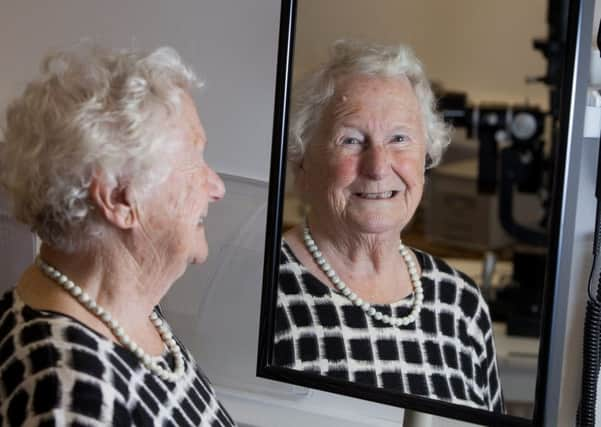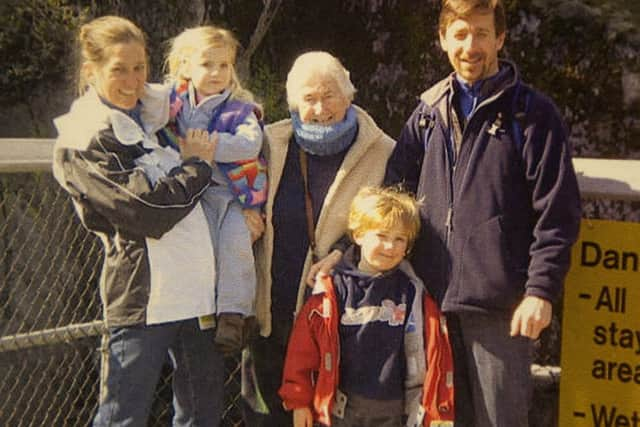Pionering eye op lets OAP see her grandchildren


Joyce Cook underwent the ground-breaking procedure, and she can now see colours, shapes, and pick out the tiny details on the faces of her eight grandchildren.
The 87-year-old volunteered to undergo a Descemet membrane endothelial keratoplasty (DMEK) - an operation where the innermost layer of the cornea is replaced.
Advertisement
Hide AdAdvertisement
Hide AdUnder the procedure, donor tissue is used to replace the damaged cornea, and it has a faster recovery time than traditional corneal transplants.


Joyce, a retired nurse from Edinburgh, said the results had “completely changed” how she sees the world and has given her “more confidence” in life.
She said: “The results are fantastic, I can see everything so clearly now, everything is tack sharp. It’s so good to be able to see colour so vividly again.
“Faces have become so much clearer, it’s wonderful. I am now able to see my grandchildren’s faces so much more vividly.
Advertisement
Hide AdAdvertisement
Hide Ad“My sight had been deteriorating for years and years, but it began getting really bad a couple of years ago and I realised that I had better stop driving, which is a great loss of independence.
“There’s been all sorts of benefits, my walking has improved as it gives me that much more confidence, and being able to see in 3D again.
“You don’t appreciate it until you don’t have it.”
Joyce underwent the surgery in June, and she said the change in her sight has enabled her to read books and newspapers again without the need for a reading tablet.
She underwent the pioneering operation at the Princess Alexandra Eye Pavilion in Edinburgh.
Advertisement
Hide AdAdvertisement
Hide AdJoyce said: “Since the operation, what was my good eye is now my bad eye. It’s been a blessing.
“Before I could only read on a Kindle, I couldn’t read a newspaper or books, but now the text is so clear and sharp.
“It’s a new technique in Scotland, and I was reassured by the fact that there was a back-up option available if something did go wrong.
“At first I did think it would be a bit of a waste on an 87-year-old, but then I thought, ‘well, I suppose they’ll need all the practice they can get’.”
Advertisement
Hide AdAdvertisement
Hide AdThe DMEK technique is being pioneered by Dr Nainglatt Tint (corr), a consultant cornea, cataract and refractive surgeon at the Princess Alexandra Eye Pavilion.
He said that the new procedure can be performed with an incision less than 3mm and gives better recovery of vision as compared to the older forms of transplantation.
Dr Tint said there was also less chance of rejection by the body.
The procedure uses just one or no stitches at all so recovery times are much faster than more traditional methods and patients will begin to see the results within days.
Advertisement
Hide AdAdvertisement
Hide AdThe new method offers patients a faster recovery time and can be performed under a local anaesthetic.
The operation replaces only the innermost layer of the cornea, called the endothelium, which is only 1/50th of a millimetre thick.
Dr Tint said: “In the past we used to remove the whole thickness of the cornea which could be up to half a millimetre thick and we would stitch a new graft in place.
“This could take months and months to heal - even up to two years and the vision will take a long time to get back to normal.
Advertisement
Hide AdAdvertisement
Hide Ad“But the latest procedure, which we are now doing, replaces the cells and the thin membrane that they sit on.
“We take that and we inject it into the eye through a 3mm incision where it is then unscrolled into place.
“The reaction from patients has been great because there’s a quicker recovery. We’re actually able to do this procedure under local anaesthetic.
“There is clear evidence that you get better vision with this method, and more importantly there is less chance of rejection, and there is now the question to introduce this procedure.”
Advertisement
Hide AdAdvertisement
Hide AdDr Tint has now gone on to perform another four operations and the others are also making a good recovery and noticing positive results.
Peter Rae, an 80-year-old freelance designer from Balerno, Edinburgh, also underwent the new treatment and said it had made a “world of difference”.
He underwent the procedure three weeks ago and believes it will allow him to continue enjoying his main hobby of driving and collecting classic cars.
Peter, who has required glasses since he was 11, also underwent cataract surgery some years ago, but gradually his vision was deteriorating.
Advertisement
Hide AdAdvertisement
Hide AdHe said: “It was a very quick and painless procedure. Before you know it they were inside the eye and then they were done.
“I’m now able to rest assured knowing that I can still drive for many years to come.
“Hopefully this will become more available to others like myself who suffer from degenerative eyesight and they can enjoy the benefits like I have.”